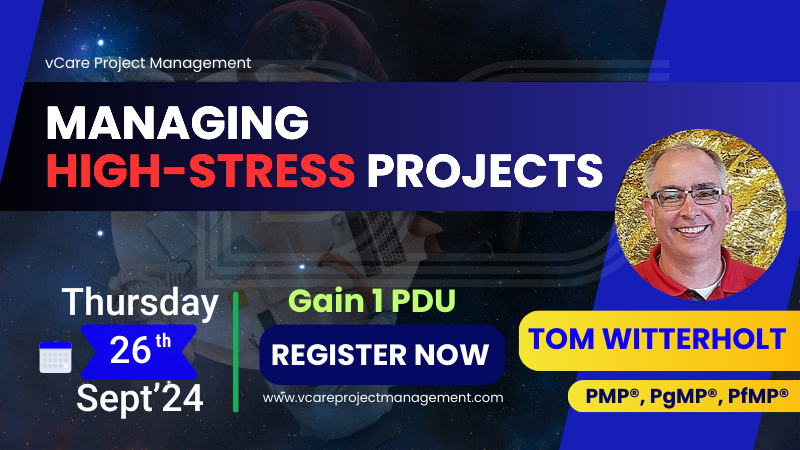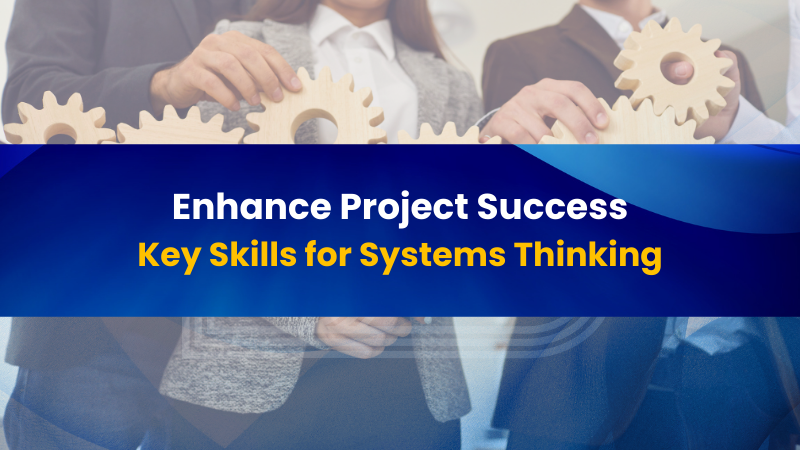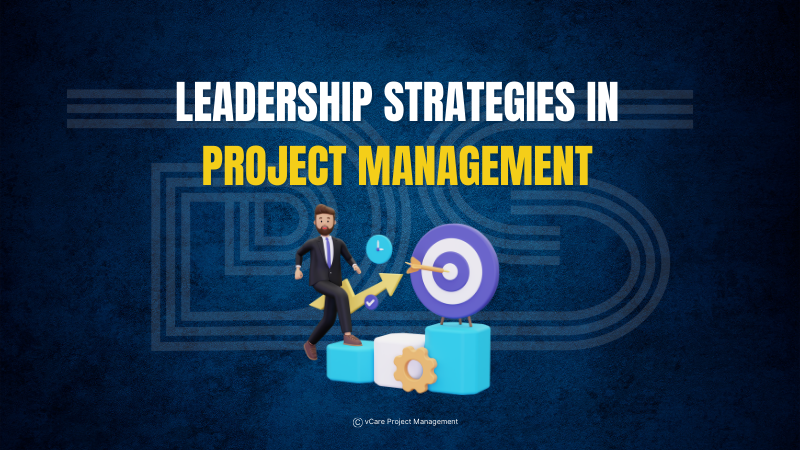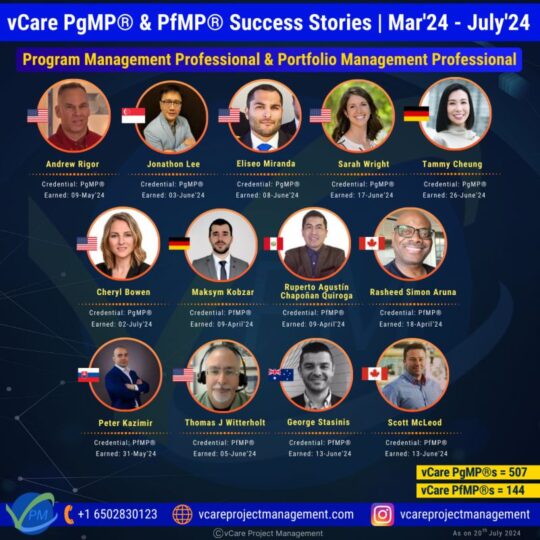
by DharamCW | Sep 6, 2024 | Professional Development Webinars
Managing High-Stress Projects | Tom Witterholt | vCare PgMP & PfMP Success Story
Join vCare Project Management for an exclusive webinar featuring Tom Witterholt, a highly accomplished Senior Program Manager with over 34 years of experience in the aerospace and defense sectors from Albuquerque, New Mexico, United States. As the keynote speaker, Tom will share his extensive expertise in managing high-stress projects.
Discussion Topics include but are not limited to,
+ Developing Strategic Thinking: Essential Skills and Learning Paths for Leaders
+ Transforming Underperformance: Leadership Techniques for Transforming Low-Performing Team Members
+ The Strategic Role in Organizational Change: How Strategy Drives Transformation
+ Navigating New Leadership Roles: Strategies for Success in Unfamiliar Territories
+ Interpreting Key Performance Indicators: Understanding and Addressing Misaligned Metrics
Attendees will earn 1 PDU and receive special discount codes for upcoming PMP®, PgMP®, and PfMP® programs. Don’t miss this chance to learn from an industry expert and take your project management skills to the next level.
🔗 Reserve your spot now: https://bit.ly/4fFJTTn
Session Date: Thursday, 26th September 2024
Session Time: 08:30 AM – 09:30 AM (HST) / 10:30 AM – 11:30 AM (AKDT) / 11:30 AM – 12:30 PM (PDT) / 12:30 PM – 01:30 PM (MDT) / 01:30 PM – 02:30 PM (CDT) / 02:30 PM – 03:30 PM (EDT) / 07:30 PM – 08:30 PM (BST) / 08:30 PM – 09:30 PM (CEST) / 09:30 PM – 10:30 PM (AST)
🚀 Elevate Your Project Management Career:
– Book an obligation-free consultation session on Project Management Career, training, and certifications: http://talktodharam.com
– Discover training offers and certification discounts: https://bit.ly/3jWVepD
– Stay updated with our Q&A series and certification success stories by subscribing to the vCare Project Management YouTube channel at https://bit.ly/2YF0wJl
– Follow my podcasts and interviews with Project Management Experts on YouTube at https://bit.ly/2NDY8wd
#HighStressProjects #ProjectManagement #FreeWebinar #PgMP #PfMP #PMI #LeadershipDevelopment #StrategicThinking #TransformationalLeadership #OrganizationalChange #PerformanceImprovement #LeadershipStrategies #ProgramManagement #DefenseIndustry #AerospaceSector #TeamManagement #StrategicLeadership #MetricsAnalysis #LeadershipSuccess #ChangeManagement #LeadershipExcellence #ProjectSuccess #ProjectLeadership #ProjectPlanning #ProjectDelivery #ProjectPortfolio #StressManagement #CrisisManagement #RiskManagement #PgMPCourse #PgMPTraining #PfMPCertification #PfMPCourse #AskDharam #DharamSingh #VcareProjectManagement

by DharamCW | Aug 28, 2024 | Leadership in Project Management, Project Management, Project-Program-Portfolio Management Knowledge
Enhance Project Success: Key Skills for Systems Thinking
As a project manager, you play a crucial role in the success of a project. A project is a system of interdependent and interacting domains of activity. Systems thinking entails a holistic view of how project parts interact with each other and external systems. Systems are constantly changing, requiring your consistent attention to internal and external conditions. Your responsiveness to system interactions allows your project teams to leverage positive outcomes.
The following skills support a systems view of the project:
– Empathy with the business areas
– Critical thinking with a big-picture focus
– Challenging assumptions and mental models
– Seeking external review and advice
– Use of integrated methods, artifacts, and practices so there is a common understanding of project work, deliverables, and outcomes
– Use of modeling and scenarios to envision how system dynamics may interact and react
– Proactive management of the integration to help achieve business outcomes

Enhance project success with key systems thinking skills—holistic project management in action.
By honing these skills, project teams can enhance collaboration, adaptability, and, ultimately, project success. Remember, these skills are not just beneficial; they are essential for your professional growth and the success of your projects.
🚀 Elevate Your Project Management Career:
– Register for my upcoming PMI Certification Success Story Webinars: https://bit.ly/3Lpjifb / https://bit.ly/4fJdX0c
– Book an obligation-free consultation session on Project management Career, training, and certifications: http://talktodharam.com
– Discover training offers and certification discounts: https://bit.ly/3jWVepD
– Stay updated with our Q&A series and certification success stories by subscribing to the vCare Project Management YouTube channel at https://bit.ly/2YF0wJl
– Follow my podcasts and interviews with Project Management Experts on YouTube at https://bit.ly/2NDY8wd
#SystemsThinking #ProjectManagement #SkillsDevelopment #PMBOK #PMBOK7 #PMP #Empathy #Innovation #Agile #Waterfall #ProjectLeadership #HolisticProjectManagement #CriticalThinking #PMPCertification #PMPExam #PMPTraining #BusinessAnalysis #ChangeManagement #ProjectDelivery #ProjectSuccess #ProjectTeams #SystemsDynamics #BusinessOutcomes #HybridProjectManagement #AskDharam #DharamSingh #VCareProjectManagement

by DharamCW | Aug 18, 2024 | Leadership in Project Management, Project-Program-Portfolio Management Knowledge

Master leadership strategies in project management with insights from PMBOK 7th Edition.

by DharamCW | Aug 2, 2024 | Professional Development Webinars
Leading Successful Business Transformations – Best Practices and Lessons Learned | Cheryl Bowen | vCare PgMP Success Story
Join us for an insightful webinar hosted by vCare Project Management, featuring the distinguished Cheryl Bowen, a seasoned Program and Project Management professional with over 18 years of experience in the Reinsurance industry from Ocoee, Florida, United States. Cheryl, the Principal Project Manager at Hannover Re in Germany, is known for her exceptional skills in driving complex financial system conversions and overseeing large-scale program management initiatives.
Session discussion topics include the following:
+ Ensuring High Levels of Engagement and Buy-In from Stakeholders during Transformation Projects
+ Conducting Post-Mortem Reviews after Transformation Projects
+ Ensuring Sustainability of Transformation Initiatives
+ Rethinking Business Models for Successful Transformation
+ Ensuring Effective Leadership and Team Support during Transformational Changes
Attendees will benefit from Cheryl Bowen’s expertise, earn 1 PDU, and gain valuable industry, career, and certification insights. This knowledge will empower you to navigate the complexities of project management. Additionally, attendees will receive a special discount code on our upcoming PMP, PgMP, and PfMP programs.
🔗 Reserve your spot now: https://bit.ly/3Lpjifb
Session Date: Thursday, 29th August, 2024
Session Time: 10:00 AM – 11:00 AM (PDT) / 11:00 AM – 12:00 PM (MDT) / 12:00 PM – 01:00 PM (CDT) / 01:00 PM – 02:00 PM (EDT) / 02:00 PM – 03:00 PM (BRT) / 06:00 PM – 07:00 PM (BST) / 07:00 PM – 08:00 PM (CEST) / 08:00 PM – 09:00 PM (AST) / 09:00 PM – 10:00 PM (GST) / 10:30 PM – 11:30 PM (IST)
🚀 Elevate Your Project Management Career:
– Book an obligation-free consultation session on Project Management Career, training, and certifications: http://talktodharam.com
– Discover training offers and certification discounts: https://bit.ly/3jWVepD
– Stay updated with our Q&A series and certification success stories by subscribing to the vCare Project Management YouTube channel at https://bit.ly/2YF0wJl
– Follow my podcasts and interviews with Project Management Experts on YouTube at https://bit.ly/2NDY8wd
#BusinessTransformation #ProjectLeadership #PgMPWebinar #Ocoee #Florida #USA #Germany #PMP #PgMP #PfMP #ProjectManagement #StakeholderEngagement #ProgramManagement #ChangeManagement #TransformationProjects #FinancialSystems #PostMortemReviews #SustainableChange #BusinessModels #TeamSupport #ProfessionalDevelopment #IndustryInsights #CareerGrowth #PgMPCertification #PgMPExam #PgMPCourse #PgMPTraining #AskDharam #DharamSingh #DharamSinghPgMP #DharamSinghPfMP #DharamSinghPMP #VCareProjectManagement #ProgramManagementProfessional #ProjectManagementProfessional

by DharamCW | Jul 29, 2024 | PMI Certification Success Stories
🎉 Celebrating Excellence in Program & Portfolio Management! 🎉
It’s time to celebrate the incredible achievements of a dedicated group of professionals. Congratulations to each of you who obtained your PfMP® and PgMP® certifications with the guidance and support of vCare Project Management from March to July 2024! 🚀
Many professionals will now find inspiration in your success, highlighting the effectiveness of vCare Project Management’s training and mentoring programs.
Thank you for embarking on this journey with us.
vCare’s Global Reach:
🎓 Supported 144 PfMP®s across 30 countries
🎓 Supported 507 PgMP®s across 54 countries

Congratulations to all PfMP & PgMP achievers from March to July 2024! 🚀
🌟 To Aspiring Certification Candidates Worldwide:
If you’re a Project, Program, or Portfolio Management Professional looking to boost your career, let this success story inspire you. Although the journey towards certification can be challenging, it is worth embarking on with the right guidance and support. At vCare Project Management, we are dedicated to being a part of your success story by providing you with the necessary expertise and support to help you achieve your goals.
🔍 Looking Ahead:
Accompany more professionals on their learning journey and support their growth and achievements in the upcoming years. Here’s to a year of success stories!
🚀 Elevate Your Project Management Career:
– Register for my upcoming PMI Certification Success Story Webinars: https://bit.ly/3xHeZZH / https://bit.ly/3Lpjifb
– Book an obligation-free consultation session on Project management Career, training, and certifications: http://talktodharam.com
– Discover training offers and certification discounts: https://bit.ly/3jWVepD
– Stay updated with our Q&A series and certification success stories by subscribing to the vCare Project Management YouTube channel at https://bit.ly/2YF0wJl
– Follow my podcasts and interviews with Project Management Experts on YouTube at https://bit.ly/2NDY8wd
#PgMP #PfMP #CertificationSuccess #ProjectManagement #PortfolioManagement #ProgramManager #ProjectManager #PMICertification #CareerGrowth #GlobalProfessionals #SuccessStory #ProfessionalAchievement #PMITraining #DharamSingh #vCareProjectManagement











Leadership plays a crucial role in the success of a project. In Project Management, effective leadership is essential for achieving positive outcomes. The PMBOK 7th Edition highlights various strategies that can improve leadership skills within a project team. Emphasizing skills such as focusing on agreed-upon goals, articulating motivating visions, and fostering collaboration is vital for overcoming obstacles and driving progress. From conflict resolution to promoting self-awareness, every aspect of leadership contributes to a cohesive team and project success.